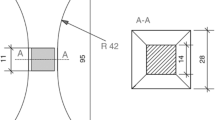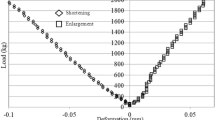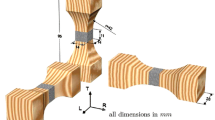Abstract
Wood with distinctively different properties in the longitudinal, radial and tangential directions exhibits a strong moisture-dependent material characteristic in the elastic range. The purpose of this study was to analyze the orthotropic elastic properties of Chinese fir wood [Cunninghamia lanceolata (Lamb.) Hook] determined at different moisture conditions using an ultrasonic wave propagation method. The results were compared with those obtained by the traditional static compression or tension tests. The results confirm that the stiffness coefficients obtained by the ultrasound without considering the complete stiffness matrix show significantly higher values than the compression or tension Young’s moduli in all the three anatomical directions at each specific MC. The differences between stiffness coefficients and Young’s moduli were significantly reduced by corrections with Poisson ratio. Only in tangential direction, the Young’s moduli with Poisson ratio correction are statistically equivalent to the Young’s moduli obtained by compression and tension.





Similar content being viewed by others
References
Astley RJ, Stol KA, Harrington JJ (1998) Modelling the elastic properties of softwood. Part 2: the cellular microstructure. Holz Roh-Werkst 56:43–50
Backman AC, Lindberg KAH (2001) Difference in wood material responses for radial and tangential direction as measured by dynamic mechanical thermal analysis. J Mater Sci 36:3777–3783
Bodig J, Jayne BA (1982) Mechanics of wood and wood composites. Van Nostrand Reinhold Company Inc., New York
Bucur V (2006) Acoustics of wood. Springer, Berlin
Bucur V, Archer RR (1984) Elastic constants for wood by an ultrasonic method. Wood Sci Technol 18:255–265
Burmester A (1965) Relationship between sound velocity and the morphological, physical and mechanical properties of wood. Holz Roh-Werkst 23:227–236
Clauss S, Pescatore C, Niemz P (2014) Anisotropic elastic properties of common ash (Fraxinus excelsior L.). Holzforschung 68:941–949
Gonçalves R, Trinca AJ, Cerri DGP (2011) Comparison of elastic constants of wood determined by ultrasonic wave propagation and static compression testing. Wood Fiber Sci 43:64–75
Gonçalves R, Trinca AJ, Cerri DGP (2014) Elastic constants of wood determined by ultrasound using three geometries of specimens. Wood Sci Technol 48:269–287
Hering S, Keunecke D, Niemz P (2012) Moisture-dependent orthotropic elasticity of beech wood. Wood Sci Technol 46:927–938
Jernqvist LO, Thuvander F (2001) Experimental determination of stiffness variation across growth rings in Picea abies. Holzforschung 55:309–317
Jiang JL, Bachtiar EV, Lu JX, Niemz P (2017) Moisture-dependent orthotropic elasticity and strength properties of Chinese fir wood. Eur J Wood Prod 75(6):927–938
Keunecke D, Sonderegger W, Pereteanu K, Lüthi T, Niemz P (2007) Determination of Young’s and shear moduli of common yew and Norway spruce by means of ultrasonic waves. Wood Sci Technol 41:309–327
Keunecke D, Hering S, Niemz P (2008) Three-dimensional elastic behavior of common yew and Norway spruce. Wood Sci Technol 42:633–647
Keunecke D, Merz T, Sonderegger W, Schnider T, Niemz P (2011) Stiffness moduli of various softwood and hardwood species determined with ultrasound. Wood Mater Sci Eng 6:91–94
Kifetew G (1999) The influence of the geometrical distribution of cell wall tissue on the transverse anisotropic dimensional changes of softwood. Holzforschung 53:347–349
Kránitz K, Deublein M, Niemz P (2014) Determination of dynamic elastic moduli and shear moduli of aged wood by means of ultrasonic devices. Mater Struct 47:925–936
Mark RE (1967) Cell wall mechanics of tracheids. Yale University Press, New Haven
McBurney RS, Drow JT (1962) The elastic properties of wood: Young’s moduli and Poisson’s ratios of Douglas-fir and their relations to moisture content. Forest Product Laboratory, Report No. 1528-D, United States Department of Agriculture, Forest Service, Forest Products Laboratory Madison, Wisconsin
Niemz P, Caduff D (2008) Research into determination of the Poisson ratio of spruce wood. Holz Roh-Werkst 66:1–4
Niemz P, Kucera L, Bernatowicz G (1999) Studies on the effect of grain angle on the propagation velocity of soundwaves in wood. Holz Roh-Werkst 57:225–225
Niemz P, Daniel H, Andreas H (2014) Physical and mechanical properties of Common Ash (Fraxinus Excelsior L.). Wood Res 59:671–682
Nzokou P, Kamdem DP (2004) Influence of wood extractives on moisture sorption and wettability of red oak (Quercus rubra), black cherry (Prunus serotina), and red pine (Pinus resinosa). Wood Fiber Sci 36(4):483–492
Oliveira FGR, Campos JAO, Pletz E, Sales A (2002) Nondestructive evaluation of wood using ultrasonic technique. Maderas Ciencia Y Tecnologia 4:133–139
Ozyhar T, Hering S, Niemz P (2012) Moisture-dependent elastic and strength anisotropy of European beech wood in tension. J Mater Sci 47:6141–6150
Ozyhar T, Hering S, Niemz P (2013a) Moisture-dependent orthotropic tension-compression asymmetry of wood. Holzforschung 67:395–404
Ozyhar T, Hering S, Sanabria SJ, Niemz P (2013b) Determining moisture-dependent elastic characteristics of beech wood by means of ultrasonic waves. Wood Sci Technol 47:329–341
Sakai H, Minamisawa A, Takagi K (1990) Effect of moisture content on ultrasonic velocity and attenuation on woods. Ultrasonics 28:382–385
Sinclair NA, Farshad M (1987) A comparison of three methods for determining elastic constants of wood. J Test Eval 15(2):77–86
Vázquez C, Gonçalves R, Bertoldo C, Bano V, Vega A, Crespo J, Guaita M (2015) Determination of the mechanical properties of Castanea sativa Mill. Using ultrasonic wave propagation and comparison with static compression and bending methods. Wood Sci Technol 49:607–622
Watanabe U (1998) Shrinkage and elastic properties of coniferous wood in relation to cellular structure. Wood Res Bull Wood Res Inst Kyoto Univ 85:1–47
Acknowledgements
This research was sponsored by the National Natural Science Foundation of China (no. 31570548). J. J. would like to gratefully acknowledge the financial support from the China Scholarship Council (CSC). A special thanks goes to Franco Michel and Thomas Schnider for their help during specimen preparation and their expert assistance in conducting the measurements.
Author information
Authors and Affiliations
Corresponding author
Ethics declarations
Ethical statement
All authors have approved this version of the article and agreed for its submission in your journal. The manuscript has not been published previously, and not under consideration for publication elsewhere. In addition, the authors declare that they fulfill all the ethical responsibilities required by the Committee on Publication Ethics (COPE).
Rights and permissions
About this article
Cite this article
Jiang, J., Bachtiar, E.V., Lu, J. et al. Comparison of moisture-dependent orthotropic Young’s moduli of Chinese fir wood determined by ultrasonic wave method and static compression or tension tests. Eur. J. Wood Prod. 76, 953–964 (2018). https://doi.org/10.1007/s00107-017-1269-5
Received:
Published:
Issue Date:
DOI: https://doi.org/10.1007/s00107-017-1269-5




